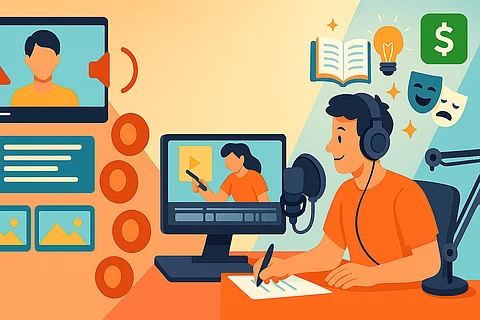
- Home
- न्यूजग्राम
- India
- World
- Politics
- Entertainment
- Culture
- Lifestyle
- Economy
- Sports
- Sp. Coverage
- Misc.
- NewsGram Exclusive
- Jobs / Internships

Starting July 15, 2025, YouTube is rolling out updated monetisation guidelines under its YouTube Partner Program (YPP). While the platform insists that the changes are minor and largely reinforce existing policies, they mark a crucial moment for creators—especially those relying on AI tools, reused clips, or mass-produced content. YouTube has made it clear: originality, authenticity, and value addition will now take centre stage for monetised content.
These changes come in response to the rise of AI-driven, low-effort, and faceless channels that flood the platform with repetitive content. The update aims to better detect “inauthentic” material while continuing to support passionate creators who bring unique voices and perspectives to the platform.
What’s Changing in YouTube’s Monetisation Guidelines?
YouTube is not introducing a completely new policy but refining how it enforces existing standards around originality and authenticity. The previous term “repetitious content” has now been officially replaced with “inauthentic content” to more accurately reflect challenges in the current digital landscape—especially with the growth of generative AI.
The update will focus on:
Limiting mass-produced content with minimal human input.
Detecting AI-generated or reused clips that lack meaningful commentary, context, or creativity.
Encouraging creators to add value—whether educational, entertaining, or insightful—to existing content.
“This is a minor update to YouTube’s long-standing YPP policies to better identify when content is mass-produced or repetitive. It is not a crackdown on reaction videos or compilations—but it is a call for originality.”
Rene Ritchie, YouTube’s Creator Liaison
New Monetisation Guidelines: What You Need to Know
The new monetisation enforcement places particular emphasis on the following areas:
1. AI-Generated and Reused Content
Creators who use AI-generated content or reuse clips from other sources can still qualify for monetisation—provided they add substantial original input. This includes elements such as commentary or analysis, educational explanations, or creative storytelling. However, content featuring generic voiceovers, text-to-speech narration, or reused visuals without meaningful modification is likely to face demonetisation.
2. Mass-Produced and Low-Effort Channels
Channels that post repetitive slideshow formats, nearly identical story narrations, or minor variations of the same content may be flagged as 'inauthentic' and risk losing monetisation unless they show clear creative contribution.
See Also:
3. Reaction, Compilation, and Clip Channels
These channels are not banned, but creators must do more than simply aggregate or react to existing content. Monetisation will apply only if videos provide genuine added value—such as insightful or humorous commentary, educational framing, or transformative editing and storytelling.
4. Vlogs, Tutorials, and Informational Content
Creators in these genres should avoid using stock footage without context, text-to-speech narration, or fully automated AI-generated content with minimal modification. YouTube encourages the use of AI tools like Dreamscreen and auto-dubbing, provided there is transparency and originality in the storytelling.
What Remains the Same in YPP?
Despite the changes in enforcement, YouTube’s core eligibility criteria for monetisation remains unchanged:
1,000 subscribers and
Either 4,000 valid public watch hours in the last 12 months or
10 million valid Shorts views in the last 90 days.
YouTube still welcomes the use of AI and third-party content—provided creators transform the material significantly and adhere to copyright and community guidelines.
YouTube’s July 2025 update is a response to growing concerns over content quality in an age of automation. While the platform isn’t banning AI or compilations, it is reinforcing the need for creativity and value. For creators who have built their channels on originality, storytelling, and community engagement, little will change. But for those relying on shortcuts or volume-based strategies, this update is a warning to rethink their approach.
As YouTube clarified: “All of this content can continue to be monetised if you’ve added significant original commentary, modifications, or educational or entertainment value.” The message is clear—authenticity is the future of monetisation on YouTube. [Rh/Eth/VP]
